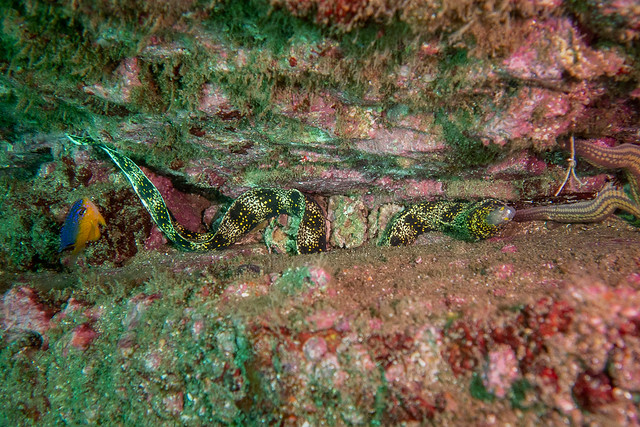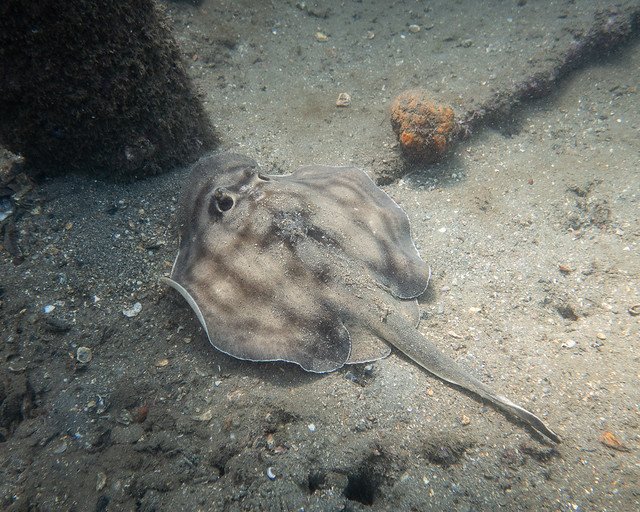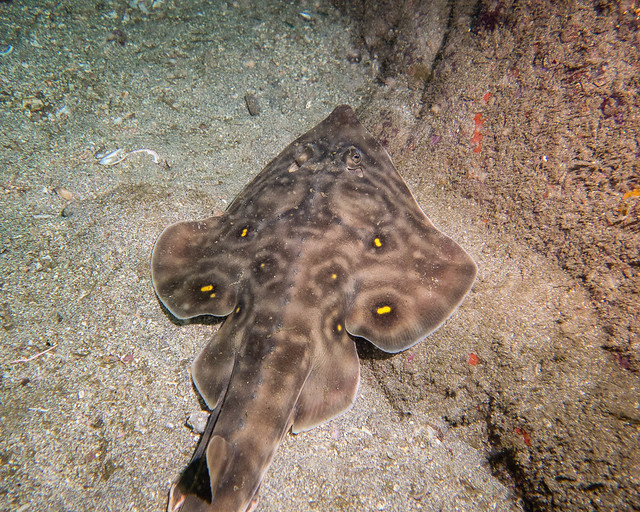We wanted to get in some scuba diving while we were in Mexico. We took our own gear with us because rental gear isn't always the best (which is a safety issue). Although the better diving is probably on the Caribbean side, we didn't want to drive that far so we stuck to the Pacific side. One of our favorite dive areas is the Sea of Cortez near Baja Mexico and we hoped there would be some similarities.
The first place we tried was Zihuatenejo. Although the young staff at the Zihuatenejo Dive Center were friendly and helpful, I was a little concerned when the dive master didn't know what a nudibranch was. Maybe it was just a language issue since he was from Germany. I didn't take my underwater camera the first day since I wanted to keep things simpler for the first dives. Unfortunately, that was the day we did shallow dives with little current, which would have been good for photography. Whereas the second day, when I did take my camera, the dives were deep with enough current to make holding still to take photographs almost impossible. Both days the visibility was quite bad, the worst we've encountered for quite a while. On the positive side, there was a lot more hard coral reef than I was expecting. There isn't much around Baja, and most of the reefs are on the Caribbean side. We did see a large seahorse on the first day. We've only ever seen tiny ones before so that was nice. It would have been nice to have my camera, although it wasn't in a very good spot to photograph. It was reddish and 4 or 5 inches long. I assume it was a Giant (or Pacific) Seahorse. We also saw a sea turtle, but with the low visibility it disappeared rapidly. We also saw a nice school of what they called "sardines".

Unfortunately, with the worst possible timing, I caught a cold right when we started diving. The second day of diving I knew I was coming down with something but I thought I could manage. Although I did ok with equalizing on the first dive, the second one gave me a massive sinus headache. After that I gave up on diving till my cold was over. Shelley went out again a third day without me. We had originally planned for four days of diving, but there weren't that many dive sites and the visibility was bad so we decided to move on.
A few days later in Manzanillo we hooked up with Octopus Garden Dive Center. We had chosen a hotel right close to the dive center (Hotelito Escondido - recommended). Although this area wasn't "downtown", it was right on the beach and had a good assortment of restaurants.
We saw five different kinds of eels, including a couple we hadn't seen before:




We only saw a few nudibranchs which I think were all Red-tipped Sea Goddesses. I only managed a decent photo of one. (It's less colorful than the one I photographed in Belize)

There were lots of stingrays around. I think most of them were Bullseye Round Stingrays like this one.

We also saw this Southern Banded Guitarfish. Guitarfish are sort of a cross between a stingray and a shark. I like the bright yellow spots.

Usually we only see one or two Moorish Idols at a time, so it was interesting to see this larger group. You can get an idea of the visibility from the background. There was a lot of swell at this point so I shot a bunch as I got pushed around and managed to get this one half decent shot.

Porcupinefish have such big eyes with interesting flecks in them. This one seemed curious about me.

I thought this was a different kind of boxfish, but it's just the male colors of the Spotted Boxfish. The females are just black with white spots. (And they can change sex and therefore coloring.)

Guineafowl Puffers also have two distinct colorings, either a similar black with white spots, or a golden phase (not connected to male/female in this case).

Scorpionfish are generally well camouflaged, but this one was almost impossible to see. I spotted one fin and figured out what it must be, but it was still almost impossible to actually see the fish.

We only saw a single fairly small lobster. I'm not sure if they are naturally uncommon here, or whether most of them have been caught.

I didn't see any Christmas Tree Worms, but there were lots of Feather Duster Worms of various colors.


The "tubes" you can see in the photo above were probably made by feather duster worms.
Given the poor visibility and the limited dive operations, we probably wouldn't bother diving in this area again. But we were still glad to have got out, and despite the conditions we saw quite a bit of stuff.
See also Shelley's post on our diving
See all 33 photos in this batch
The first place we tried was Zihuatenejo. Although the young staff at the Zihuatenejo Dive Center were friendly and helpful, I was a little concerned when the dive master didn't know what a nudibranch was. Maybe it was just a language issue since he was from Germany. I didn't take my underwater camera the first day since I wanted to keep things simpler for the first dives. Unfortunately, that was the day we did shallow dives with little current, which would have been good for photography. Whereas the second day, when I did take my camera, the dives were deep with enough current to make holding still to take photographs almost impossible. Both days the visibility was quite bad, the worst we've encountered for quite a while. On the positive side, there was a lot more hard coral reef than I was expecting. There isn't much around Baja, and most of the reefs are on the Caribbean side. We did see a large seahorse on the first day. We've only ever seen tiny ones before so that was nice. It would have been nice to have my camera, although it wasn't in a very good spot to photograph. It was reddish and 4 or 5 inches long. I assume it was a Giant (or Pacific) Seahorse. We also saw a sea turtle, but with the low visibility it disappeared rapidly. We also saw a nice school of what they called "sardines".

Unfortunately, with the worst possible timing, I caught a cold right when we started diving. The second day of diving I knew I was coming down with something but I thought I could manage. Although I did ok with equalizing on the first dive, the second one gave me a massive sinus headache. After that I gave up on diving till my cold was over. Shelley went out again a third day without me. We had originally planned for four days of diving, but there weren't that many dive sites and the visibility was bad so we decided to move on.
A few days later in Manzanillo we hooked up with Octopus Garden Dive Center. We had chosen a hotel right close to the dive center (Hotelito Escondido - recommended). Although this area wasn't "downtown", it was right on the beach and had a good assortment of restaurants.
We saw five different kinds of eels, including a couple we hadn't seen before:




We only saw a few nudibranchs which I think were all Red-tipped Sea Goddesses. I only managed a decent photo of one. (It's less colorful than the one I photographed in Belize)

There were lots of stingrays around. I think most of them were Bullseye Round Stingrays like this one.

We also saw this Southern Banded Guitarfish. Guitarfish are sort of a cross between a stingray and a shark. I like the bright yellow spots.

Usually we only see one or two Moorish Idols at a time, so it was interesting to see this larger group. You can get an idea of the visibility from the background. There was a lot of swell at this point so I shot a bunch as I got pushed around and managed to get this one half decent shot.

Porcupinefish have such big eyes with interesting flecks in them. This one seemed curious about me.

I thought this was a different kind of boxfish, but it's just the male colors of the Spotted Boxfish. The females are just black with white spots. (And they can change sex and therefore coloring.)

Guineafowl Puffers also have two distinct colorings, either a similar black with white spots, or a golden phase (not connected to male/female in this case).

Scorpionfish are generally well camouflaged, but this one was almost impossible to see. I spotted one fin and figured out what it must be, but it was still almost impossible to actually see the fish.

We only saw a single fairly small lobster. I'm not sure if they are naturally uncommon here, or whether most of them have been caught.

I didn't see any Christmas Tree Worms, but there were lots of Feather Duster Worms of various colors.


The "tubes" you can see in the photo above were probably made by feather duster worms.
Given the poor visibility and the limited dive operations, we probably wouldn't bother diving in this area again. But we were still glad to have got out, and despite the conditions we saw quite a bit of stuff.
See also Shelley's post on our diving
See all 33 photos in this batch
No comments:
Post a Comment